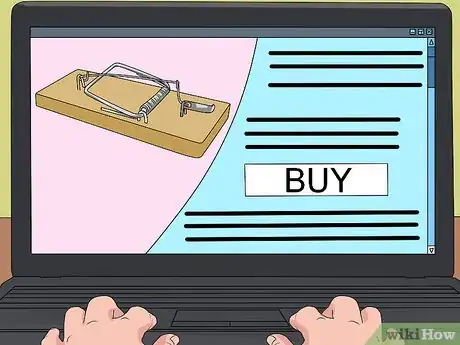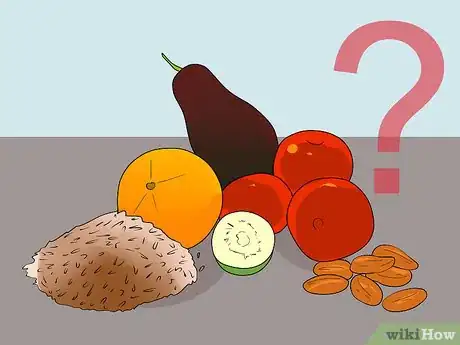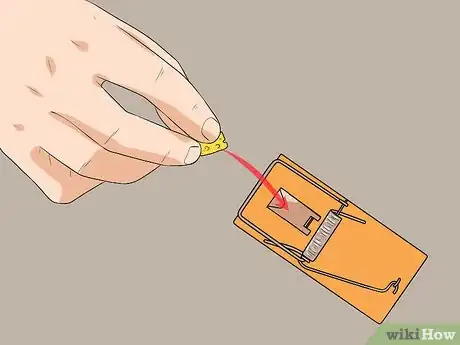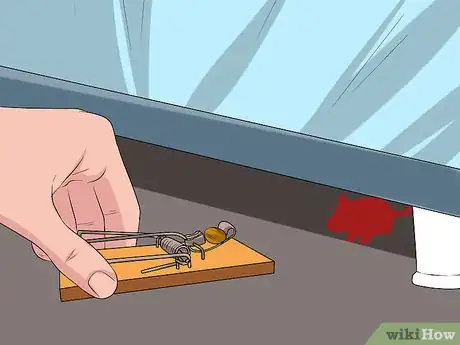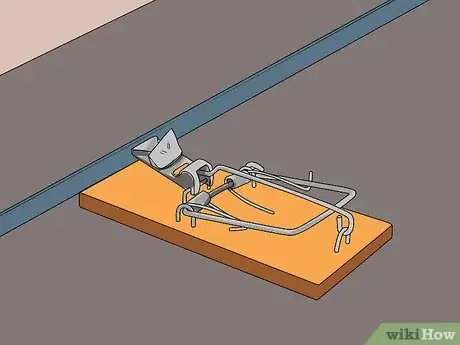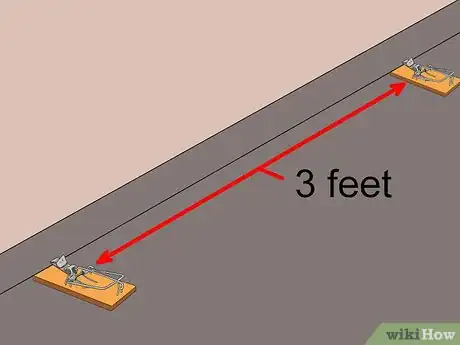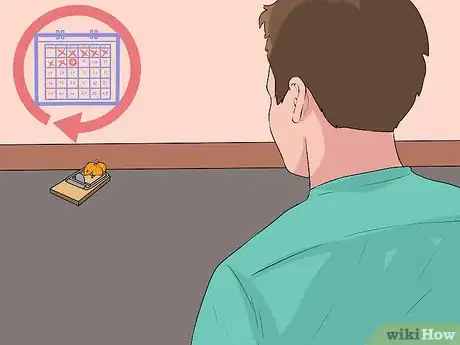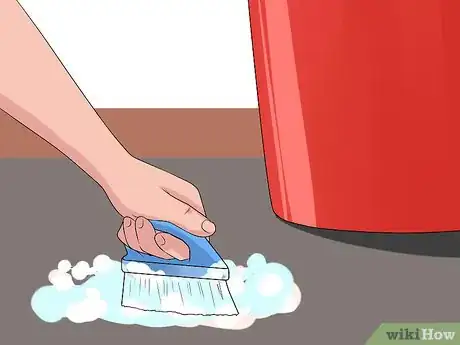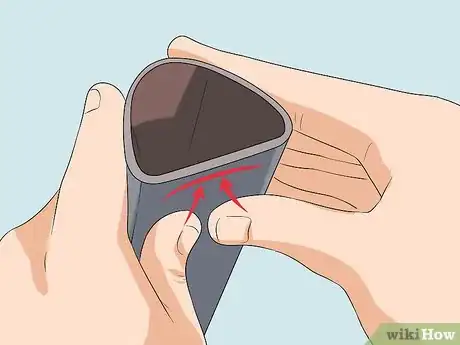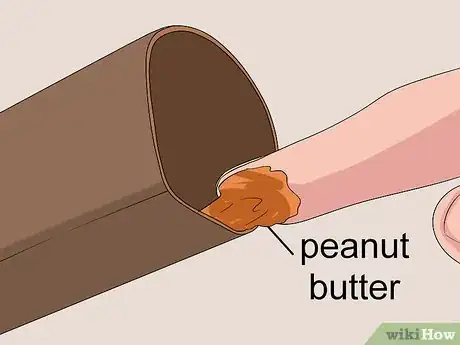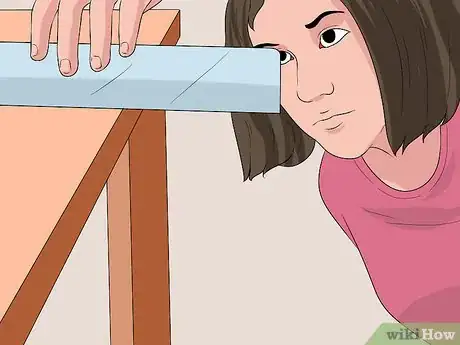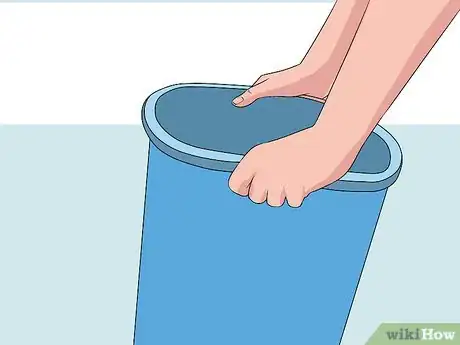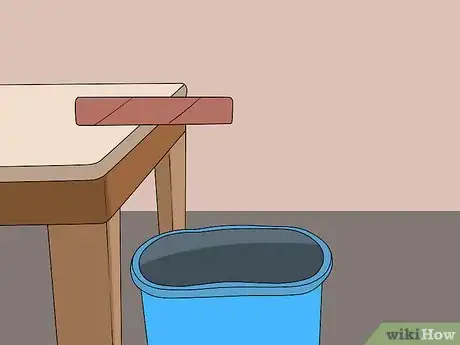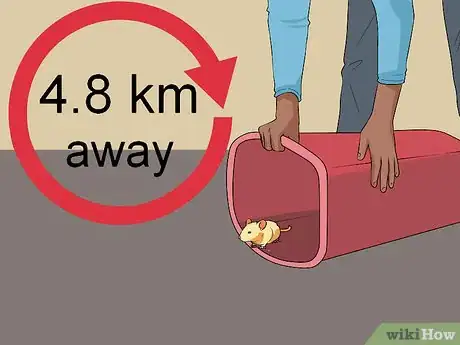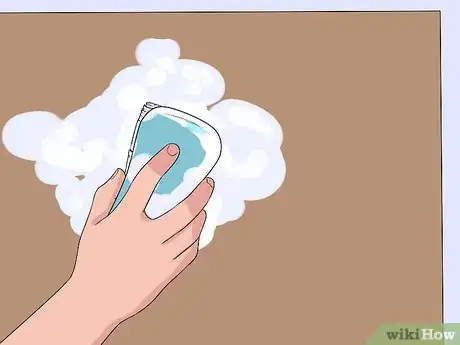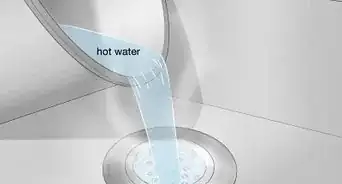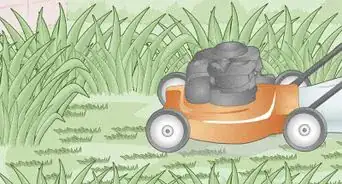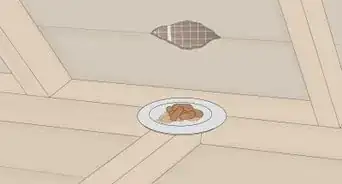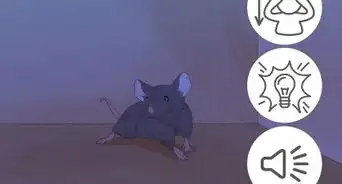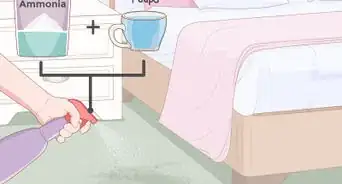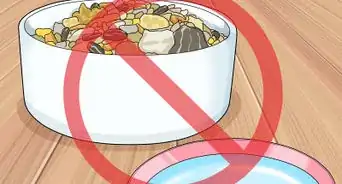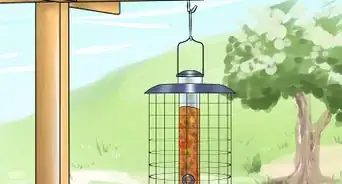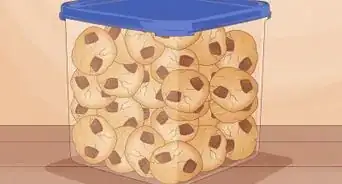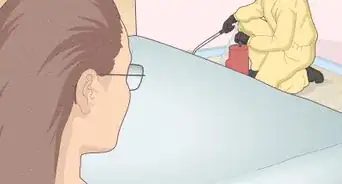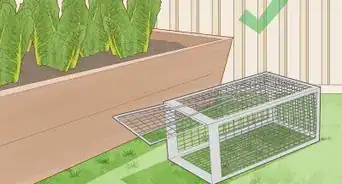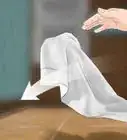This article was co-authored by Kevin Carrillo. Kevin Carrillo is a Pest Control Specialist and the Senior Project Manager for MMPC, a pest control service and certified Minority-owned Business Enterprise (MBE) based in the New York City area. MMPC is certified by the industry’s leading codes and practices, including the National Pest Management Association (NPMA), QualityPro, GreenPro, and The New York Pest Management Association (NYPMA). MMPC's work has been featured in CNN, NPR, and ABC News.
There are 10 references cited in this article, which can be found at the bottom of the page.
This article has been viewed 812,152 times.
Have you seen the telltale pellet-shaped droppings or heard clawing and squeaking in the walls? You have a visitor or, potentially, a few. Mice are intrusive pests that chew on household materials while spreading potentially deadly diseases. These rodents can be handled with store-bought mechanical traps or homemade humane traps. To catch a mouse, bait a trap with an appealing food such as peanut butter, put it against a wall or near a bucket, then dispose of the mouse when done.
Steps
Choosing and Baiting Traps
-
1Purchase several traps. Mouse traps come in many types, including traditional spring-loaded traps, electric traps, and glue traps. They vary in their method of eliminating mice but are handled in basically the same way. These can all be purchased at most hardware stores and online. Multiple traps are useful for ensnaring a single mouse, but mice spread quickly so you may have more than one in your home.[1]
- Avoid poison. The mouse will eat the poison and die somewhere hidden. In addition, the poison can be eaten by children and animals.
- Glue traps are the least humane. The mouse will either starve to death or chew off its own leg and die in an unknown location.
-
2Pick a bait. Forget the idea that mice eat cheese. While cheese can work, mice eat grains, fruit, and seeds in the wild. Peanut butter is a common household foodstuff that mice love. High-fat, high-protein, and sugary foods also attract them, such as bacon and chocolate. The stronger the object smells and the softer it is, the more likely the mouse will be to respond.[2]Advertisement
-
3Bait a trap. Be careful not to use too much bait. Keep your bait to the size of a pea and place it firmly inside the trap. Many people make the mistake of adding too much bait. On a spring trap, for example, this allows the mouse to eat without stepping onto the trap.[3]
- It is best to bait the trap before you set it. In spring-loaded traps, for example, it’s easy to trigger the trap and have it snap closed on your fingers.
- Keeping the bait thin can also force the mouse to work more to eat it. Peanut butter for instance when left in a thin coating will start to dry.
-
4Find a location where you think the mice will be. Mice like enclosed dark spaces, such as in a cupboard or under furniture. They often stick near walls when scurrying about. You may find rat droppings or smell urine.
Setting the Traps
-
1Place a trap. Go back to where you found evidence of the mouse. Now push the trap all the way to the wall. The baited trigger part or opening should be in contact with the wall. For a standard spring trap, the mechanical part should be away from the wall. Mice run along the wall, so this is more likely to attract them and, if the trap is perpendicular to the wall, prevent them from triggering it prematurely.[4]
-
2Set multiple traps. At a maximum of two or three feet (.6-.9 meters) away along the wall, set another trap. Repeat this in both directions until the high-traffic areas are covered. Of course, even for one mouse, multiple baited traps increase the likelihood of catching it. But if one mouse got in, another might have also and they reproduce quickly.
- You may have multiple areas with a lot of mice traffic. Cover those areas too.
-
3Check the traps every day. Return often to see if the trap has been activated. If you’ve caught a mouse, you need to dispose of it quickly or else the mouse will start to decompose, creating an awful smell while attracting other pests and bacteria.
-
4Dispose of the mouse. Put on protective gloves and possibly a breathing mask. Throw disposable traps away and take them to the dumpster to avoid lingering smells in your home.[5]
- When on a budget, traps can be reused. Scrub them thoroughly with soap and water while wearing disposable gloves. Throw the gloves away before resetting the traps.
-
5Clean up contaminated areas. Be sure to wash your hands after handling the mouse and cleaning up your house. Pick up droppings with a paper towel, launder fabrics, and scrub surfaces with soap and water to avoid exposure to harmful bacteria.
Making a Humane Trap
-
1Get a paper towel tube. Save an empty cardboard tube from a roll of paper towels or toilet paper. Similar objects can be used as long as they’re big enough for the mouse to fit inside but also flimsy enough to not support the mouse’s weight.
- Stores may also carry humane traps. Check at your hardware store or online.
-
2Flatten one side of the tube. Run your fingers along the length of the tube on one side, pressing in as you go. When finished, the tube should be able to rest flat-side-down on a counter or table.[6]
-
3Bait the tube. Place bait on one end of the tube. A small dollop of peanut butter, some cracker crumbs, or a sliver of bacon will be enough to attract the mouse. Peanut butter works well because it sticks to the inside of the tube.
-
4Balance the tube on the edge of a counter or table. Choose an edge that is a few feet off the ground but also has some free floor space under it. Place the tube flat-side-down with the baited end off the counter, then push the tube until it is half off the edge.[7]
- If you’re having trouble getting the tube to stay still or balance, you can tape it lightly. Make sure the tape isn’t holding it tight enough that it won’t move when the mouse is inside.
- If you do not have a table or counter that will work, you can instead construct a ramp up to the top of the bucket. Numerous objects, including cardboard or stacked wood, can be used as long as the ramp is sturdy enough to support the mouse’s weight.
-
5Get a bucket or trashcan. Find an empty container that will catch the mouse. Make sure the container is at least two feet tall or else the mouse may escape the trap.
-
6Place the bucket underneath the tube. Your catching container goes directly under the baited end of the tube hanging off the table. When the mouse moves in to get the bait, its weight causes the tube to fall off the table and into the bucket.[8]
-
7Check your trap frequently. Come back at least once a day to see if the tube is in place, the bait has been eaten, or a mouse is in the bucket. Make adjustments, such as rebalancing the tube. If a mouse is caught, it must be moved soon or else it will starve. Starving mice will also eat one another.
-
8Release the mouse outside. The mouse needs to be moved at least a mile (1.6 km) away. This prevents the mouse from returning to your home. To keep the mouse safe from predators, go no further than three miles (4.8 km). Find an area with cover, such as wooded areas, wood piles, or rocky ground and consider leaving food in such enclosed areas until the mouse can get established.[9]
- Food options include uncooked oatmeal, peanuts, bird seed, and dry pet food.
-
9Disinfect surfaces where the mouse has traveled. These surfaces may contain dangerous bacteria from the mouse. Pick up droppings using paper towels and scrub surfaces with soap and water. Don’t forget to wash your hands.
Expert Q&A
Did you know you can get expert answers for this article?
Unlock expert answers by supporting wikiHow
-
QuestionHow do you get rid of mice that are inside the walls?
 Kevin CarrilloKevin Carrillo is a Pest Control Specialist and the Senior Project Manager for MMPC, a pest control service and certified Minority-owned Business Enterprise (MBE) based in the New York City area. MMPC is certified by the industry’s leading codes and practices, including the National Pest Management Association (NPMA), QualityPro, GreenPro, and The New York Pest Management Association (NYPMA). MMPC's work has been featured in CNN, NPR, and ABC News.
Kevin CarrilloKevin Carrillo is a Pest Control Specialist and the Senior Project Manager for MMPC, a pest control service and certified Minority-owned Business Enterprise (MBE) based in the New York City area. MMPC is certified by the industry’s leading codes and practices, including the National Pest Management Association (NPMA), QualityPro, GreenPro, and The New York Pest Management Association (NYPMA). MMPC's work has been featured in CNN, NPR, and ABC News.
MMPC, Pest Control Specialist
-
QuestionWhere is the best place to put mouse traps?
 Hussam Bin BreakHussam Bin Break is a Certified Commercial Pesticide Applicator and Operations Manager. He and his brother Hussam co-founded Diagno Pest Control in the greater Philadelphia area in 2018, and have since expanded their services to include the New Jersey market. Diagno Pest Control has received Home Advisor's Top Rated and Elite Service Badges for quality of work and customer service.
Hussam Bin BreakHussam Bin Break is a Certified Commercial Pesticide Applicator and Operations Manager. He and his brother Hussam co-founded Diagno Pest Control in the greater Philadelphia area in 2018, and have since expanded their services to include the New Jersey market. Diagno Pest Control has received Home Advisor's Top Rated and Elite Service Badges for quality of work and customer service.
Pest Control Professional
-
QuestionIs it possible to keep mice out of your house?
 Kevin CarrilloKevin Carrillo is a Pest Control Specialist and the Senior Project Manager for MMPC, a pest control service and certified Minority-owned Business Enterprise (MBE) based in the New York City area. MMPC is certified by the industry’s leading codes and practices, including the National Pest Management Association (NPMA), QualityPro, GreenPro, and The New York Pest Management Association (NYPMA). MMPC's work has been featured in CNN, NPR, and ABC News.
Kevin CarrilloKevin Carrillo is a Pest Control Specialist and the Senior Project Manager for MMPC, a pest control service and certified Minority-owned Business Enterprise (MBE) based in the New York City area. MMPC is certified by the industry’s leading codes and practices, including the National Pest Management Association (NPMA), QualityPro, GreenPro, and The New York Pest Management Association (NYPMA). MMPC's work has been featured in CNN, NPR, and ABC News.
MMPC, Pest Control Specialist
Warnings
- Always wash thoroughly after a mouse is present or after handling a mouse.⧼thumbs_response⧽
- Do not use poison. It does not kill quickly and leaves a mess you may not find until it starts to stink. Poison can easily be consumed by children and pets.⧼thumbs_response⧽
- Avoid glue traps. These are usually inhumane and ineffective because the mouse can rip off its leg and die somewhere else if it doesn’t starve first.⧼thumbs_response⧽
Things you'll need
Traditional trap method:
- Trap of your choice
- Bait such as peanut butter
Homemade humane trap method:
- Toilet paper roll
- Bait
- Bucket or trashcan
- Free counter or table edge
References
- ↑ http://adequateman.deadspin.com/the-correct-way-to-catch-and-kill-mice-1745765045
- ↑ http://how-to-get-rid-of-mice.com/mouse-trap-bait/
- ↑ http://www.victorpest.com/articles/mouse-trap-mistakes
- ↑ https://www.terminix.com/blog/diy/the-eight-best-ways-to-get-rid-of-mice
- ↑ http://www.apartmenttherapy.com/how-to-catch-a-mouse-our-biggest-most-helpful-posts-215032
- ↑ http://www.wildlifeanimalcontrol.com/mousecatch.html
- ↑ http://www.wideopenspaces.com/8-diy-mouse-traps-guaranteed-catch-pesky-mouse/
- ↑ http://www.motherearthnews.com/diy/live-mouse-trap-zmaz80sozraw
- ↑ http://mouseranch.com/FYI/wildRelease.shtml
About This Article
To catch a mouse, start by buying a few mouse traps online or from a grocery or hardware store. Spring-loaded traps are an effective and inexpensive option, and are more humane than glue traps. Bait the traps with foods that are high in fat, sugar and protein. While cheese can work as bait, better choices are peanut butter, bacon, chocolate, or pet food. Because of its sticky consistency, peanut butter is often a very effective option. Set the traps, then place them in spots where you’ve seen evidence of a mouse, and check on them every day to see if you’ve caught one. To make your own mousetrap, start by partially flattening an empty paper towel roll so it can rest on a flat surface without rolling. Then, put some bait that won’t fall out, like peanut butter, on the inside of one end of the tube. Once you’ve added the bait, balance the tube on the end of a counter or table near where you’ve seen the mouse. Place a tall bucket or trash can directly below it. Wait for the mouse to crawl through the tube to get the bait, which will cause it to fall into the bucket or can. Check the can daily, or any time you notice the tube has fallen. Once you’ve caught the mouse in the bucket, carry it outside well away from your home before letting it go. If you want to learn how to use standard mousetraps to catch a mouse, keep reading!
